Some type of Magnetic Separator is always advisable and should be a standard piece of equipment in every mill. When one (Suspended Type) Magnet is located just ahead of the primary jaw crusher, and another is placed before the intermediate crusher, all danger of damage to the crushers from tramp iron is eliminated. The tramp iron usually consists of stray bits from drills, hammerheads, and other tools which can seriously damage crushing equipment.
The suspended type of Magnetic Separator has its place where space is not the deciding factor. The suspension of the magnet above the ore conveyor preceding the jaw crusher allows it to be swung aside when replacing conveyor belt or working on the conveyor pulley; and also for periodical removal of adhering tramp iron to maintain maximum efficiency. The suspension principle makes this a low cost unit.
Care should be used in the selection of this type of magnet as the width of the conveyor belt, the proper depth of the ore being conveyed, and the average percentage of foreign material to be eliminated, determine the size of magnet used. The magnets are made in circular or rectangular types and may be suspended on either a trolley or crane, or on the stationary suspension principle.
Let us make recommendations for the correct size and type of this low cost magnet best suited to your needs.

Alnico Horseshoe Magnet
The Alnico Horseshoe Magnet is a small, extremely powerful, hand magnet. It is an alloy of aluminum, nickel, and cobalt, very high in retentivity, and many times stronger than the ordinary horseshoe magnet. It is extremely resistant to demagnetization and is affected only slightly by shock or temperatures as high as 1200° F. This magnet provides an invaluable tool for the assayer, mineralogist, and plant operator. Minerals that are even moderately magnetic may be separated from non-magnetic material with this magnet and it is small and light enough to carry about in your pocket.
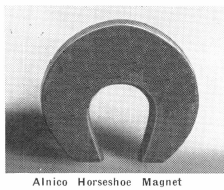

Magnetic Pulley
The high intensity Magnetic Pulley is one of the most satisfactory and economical magnets in use today. It is a sure way of getting a practically iron-free product. The low cost of current consumption, positive operation, low maintenance, and moderate initial cost, all have a definite place in planning or improving every efficient milling, processing, or industrial plant.
The greatest asset of the Magnetic Pulley is the ability of this compact, efficient unit to attract and hold the tramp material to the surface of the drum until it is away from the material being conveyed. The weight of the iron brings it to the bottom of the conveyed material and it is thus in an ideal position to be attracted to the Magnetic Pulley more quickly. The tramp material is then disposed of when the revolving drum or cylinder reaches the “demagnetized field or dead spot” on the under side of the drum and the iron is allowed to drop into a bin provided for this purpose.
No one type of Magnetic Pulley will be adaptable to every need, although there is a Magnetic Pulley for every specific application. The design used for collecting tramp iron is entirely different from that used for purification or concentration purposes. The construction of the Magnetic Pulley is such as to allow the maximum flux density to be obtained. Each section is a separate magnet (having a separate casting) with its own coil, core, and north and south poles. The Magnetic Pulley is cool operating which prolongs the life of the pulley and is necessary in order that the unit maintain its most efficient operation.
The Magnetic Pulley is used as a head pulley of a conveyor and very often the shaft of the Magnetic Pulley can be made to correspond with the shaft of the original pulley. It is necessary then only to place the Magnetic Pulley shaft into the existing bearings.
The collector ring housing is attached to any suitable bracket. The contact rings are in place on the shaft. The switch cabinet is completely wired, and the connection between it and the contact brushes is accomplished quickly.
Magnetic Pulleys operate on direct current only. They are wound for either 110 or 220 volts, although higher voltage can be used when specified. Alternating current is not suitable, and when direct current is not available, a generator, motor-generator set, or a rectifier is installed to convert the alternating current to direct current. However, these generator sets are of small size because of the nominal current requirements of the pulley.
A large range of sizes, both in diameter and width, is available and there is a capacity to suit every individual requirement. Pulley width required is determined by the width of the conveyor belt used and the diameter of a Magnetic Pulley determines its strength; the larger the diameter the greater the strength. Data necessary for recommendations is kind of material to be treated, size of material, amount to be handled per hour, whether wet or dry, purpose of separation, and characteristics of available current supply.
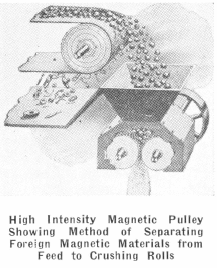

Wet Magnetic Separator
The Dings-Crockett High Intensity (Wet Type) Submerged Belt Magnetic Separator is designed for wet separations. It has found wide application in the concentration of magnetite, ilmenite, and other materials of similar magnetic susceptibility where it gives an amazingly clean-cut separation of tailings, middlings, and concentrates. Its magnetic efficiency is well above 99%.
The separator will efficiently handle large capacities of unsized ore from minus ¼” down to the finest dust. Control of the separator is simple, steady, and not critical. Feed rates may be varied over a wide range and practically the same results obtained.
The unit consists of a stationary curved bank of twenty magnets, partly submerged in water, under which passes a thin conveyor belt. Magnet pole pieces are therefore kept in close contact with belt.
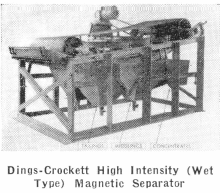
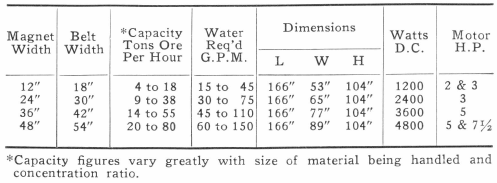
Cross Belt Magnetic Separator
The Dings Rowand-Wetherill Magnetic Separator handles many materials which cannot be handled satisfactorily by any other type of magnetic separator. Even the finest material can be readily separated with highest efficiency.
The material to be treated (which must be absolutely dry) flows from the hopper onto the feed roller which spreads it in a thin, uniform layer over the whole width of the conveyor belt as it travels toward the poles of the magnet system. As the material passes between the poles of the first magnet the magnetic particles are strongly attracted toward the upper pole and jump toward it. They are intercepted by the cross belt which removes them quickly from the influence of the magnets and allows them to drop into a receptacle provided at one side. The use of a series of magnets of different strengths permits the separation from one another of materials having different magnetic permeabilities, as well as the separation of magnetic materials. The separate removal of the strongest as well as the weakest magnetic mineral is possible.
The capacity of any magnetic separator depends on so many variables that it is impossible to estimate the exact tonnage until a test has been made and all necessary data received. Let us engineer your proposed installation.

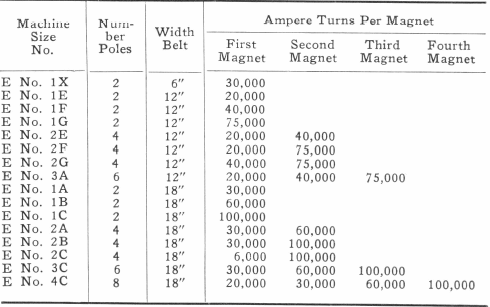
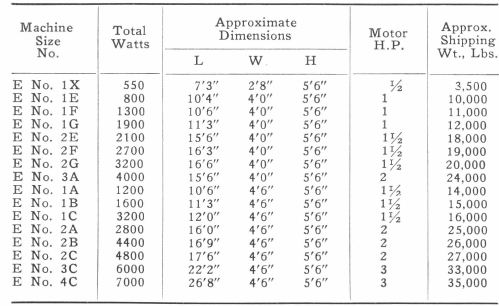
Ring Magnetic Separator
The Stearns (Ring Type) Magnetic Separator differs materially from the cross belt type machine. A steel take-off ring is employed in place of a cross belt to intercept and carry the magnetic material beyond the conveyor belt to final delivery. It has been found in certain applications that the steel take-off ring actually improves the separation. The ring has a broad flat surface adjacent to the magnetic pole to receive and carry the flux built up by the magnet. The sides are shaped to form a parabolic curve ending in a defined peak where the concentrated field is produced. The magnetic material is attracted from the feed belt to the inductively magnetized moving ring, which forms a part of the magnet pole, while in the field. In moving away from the field the ring carries the magnetic particles beyond the conveyor belt, effecting an automatic discharge as it approaches the zero point between the plus and minus poles.
The magnetic gap on this unit can be opened or closed within fixed limits by a simple and very convenient adjustment. Adjustments are usually made while the machine is operating. This applies not only to the magnetic air gap, but also to the flux density of the magnetic field, as the power or attractive force of the magnet is regulated by a rheostat which controls the amount of current used. Such adjustments will accommodate a wide range of sizings and variable magnetic permeability of materials.
Capacities of magnetic separator units vary widely as their most efficient operation depends upon a large number of factors. It is therefore impossible to estimate the exact tonnage that can be handled without complete data and preliminary tests. Let us engineer your installation.
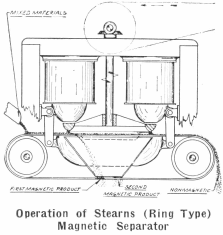
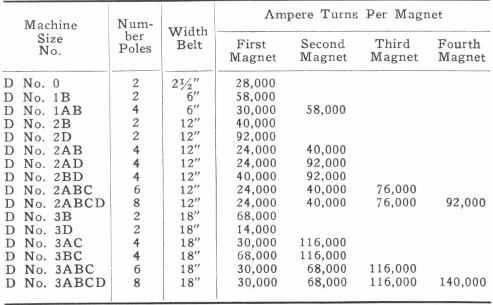
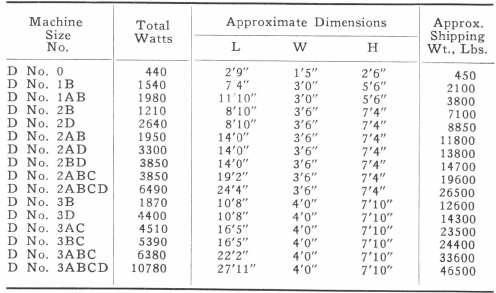
Source: This article is a reproduction of an excerpt of “In the Public Domain” documents held in 911Metallurgy Corp’s private library.
Related: Best Fishing Magnet Kit
